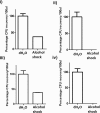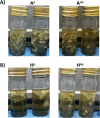Emergence of a non-sporulating secondary phenotype in Clostridium (Clostridioides) difficile ribotype 078 isolated from humans and animals
- PMID: 31548637
- PMCID: PMC6757067
- DOI: 10.1038/s41598-019-50285-y
Emergence of a non-sporulating secondary phenotype in Clostridium (Clostridioides) difficile ribotype 078 isolated from humans and animals
Abstract
Clostridium (Clostridioides) difficile is a Gram positive, spore forming anaerobic bacterium that is a leading cause of antibiotic associated diarrhoea in the developed world. C. difficile is a genetically diverse species that can be divided into 8 phylogenetically distinct clades with clade 5 found to be genetically distant from all others. Isolates with the PCR ribotype 078 belong to clade 5, and are often associated with C. difficile infection in both humans and animals. Colonisation of animals and humans by ribotype 078 raises questions about possible zoonotic transmission, and also the diversity of reservoirs for ribotype 078 strains within the environment. One of the key factors which enables C. difficile to be a successful, highly transmissible pathogen is its ability to produce oxygen resistant spores capable of surviving harsh conditions. Here we describe the existence of a non-sporulating variant of C. difficile ribotype 078 harbouring mutations leading to premature stop codons within the master regulator, Spo0A. As sporulation is imperative to the successful transmission of C. difficile this study was undertaken to investigate phenotypic characteristics of this asporogenous phenotype with regards to growth rate, antibiotic susceptibility, toxin production and biofilm formation.
Conflict of interest statement
The authors declare no competing interests.
Figures









Similar articles
-
Spo0A differentially regulates toxin production in evolutionarily diverse strains of Clostridium difficile.PLoS One. 2013 Nov 13;8(11):e79666. doi: 10.1371/journal.pone.0079666. eCollection 2013. PLoS One. 2013. PMID: 24236153 Free PMC article.
-
Emerging Clostridioides difficile ribotypes have divergent metabolic phenotypes.mSystems. 2025 Mar 18;10(3):e0107524. doi: 10.1128/msystems.01075-24. Epub 2025 Feb 27. mSystems. 2025. PMID: 40013784 Free PMC article.
-
The relationship between phenotype, ribotype, and clinical disease in human Clostridium difficile isolates.Anaerobe. 2013 Dec;24:109-16. doi: 10.1016/j.anaerobe.2013.04.003. Epub 2013 Apr 20. Anaerobe. 2013. PMID: 23608205 Free PMC article.
-
The Clostridium difficile PCR ribotype 027 lineage: a pathogen on the move.Clin Microbiol Infect. 2014 May;20(5):396-404. doi: 10.1111/1469-0691.12619. Epub 2014 Apr 28. Clin Microbiol Infect. 2014. PMID: 24621128 Review.
-
Clostridioides difficile spore: coat assembly and formation.Emerg Microbes Infect. 2022 Dec;11(1):2340-2349. doi: 10.1080/22221751.2022.2119168. Emerg Microbes Infect. 2022. PMID: 36032037 Free PMC article. Review.
Cited by
-
Foodborne Clostridioides Species: Pathogenicity, Virulence and Biocontrol Options.Microorganisms. 2023 Oct 3;11(10):2483. doi: 10.3390/microorganisms11102483. Microorganisms. 2023. PMID: 37894141 Free PMC article. Review.
-
The inhibitory effects of live and UV-killed Akkermansia muciniphila and its derivatives on cytotoxicity and inflammatory response induced by Clostridioides difficile RT001 in vitro.Int Microbiol. 2024 Apr;27(2):393-409. doi: 10.1007/s10123-023-00398-2. Epub 2023 Jul 21. Int Microbiol. 2024. PMID: 37479958
References
-
- Miller BA, Chen LF, Sexton DJ, Anderson DJ. Comparison of the Burdens of Hospital-Onset, Healthcare Facility-Associated Clostridium difficile Infection and of Healthcare-Associated Infection due to Methicillin-Resistant Staphylococcus aureus in Community Hospitals. Infect. Control Hosp. Epidemiol. 2011;32:387–390. doi: 10.1086/659156. - DOI - PubMed
Publication types
MeSH terms
Substances
LinkOut - more resources
Full Text Sources
Molecular Biology Databases
Research Materials

